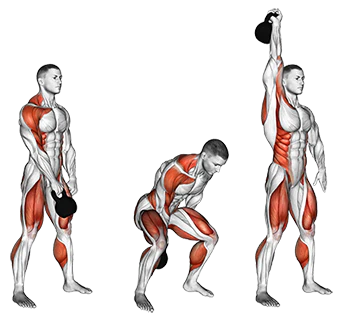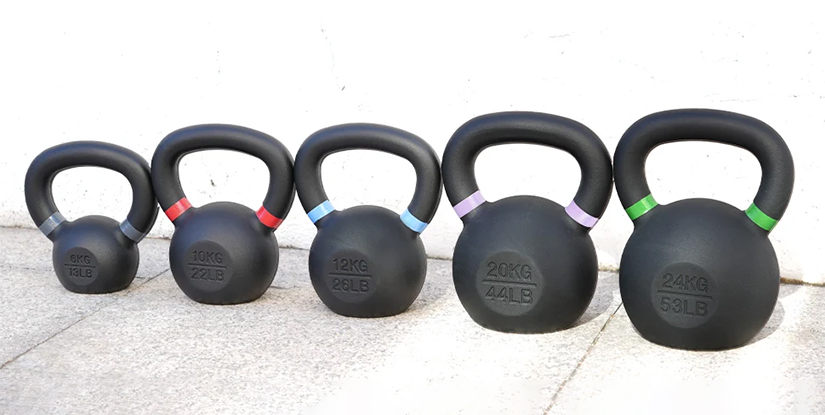So the kettlebell half snatch kept popping up everywhere—but no one was really explaining it. I figured I’d give it a go because, let’s be real, the full snatch was just a bit much for me at the time. It was just too harsh on my shoulders and wrists.
At the time, I was stuck in a rut with heavy clean & presses. They were wearing me out—more grind, less fun. I needed something explosive but smoother. That’s when I started messing around with the half snatch.
Initially? I was totally guessing. Didn’t know if my form was trash or halfway decent. Anyway, after playing around with it for a few months—fixing little things, watching videos of myself, and messing up more times than I can count—I finally started to nail it. And honestly, it ended up being just what I was looking for.
What Is the Kettlebell Half Snatch?
It’s like a regular snatch—but with a smoother exit.
You still launch the bell overhead like in a full snatch. But instead of letting it crash down or swing back into another rep from the top, you guide it back to the rack position first. That one change makes a huge difference—less jarring on the shoulders, easier to control.
You can either pull it straight from the ground or clean it to rack first. I started from the rack to focus on form. Ground-to-overhead came later.

Step-by-Step Technique
Here’s the breakdown I wish someone gave me earlier:
- Start tight – Hike the Kettlebell back like a swing. Keep it close.
- Hips do the work – Explode with your hips, not your arms.
- Let it float – Don’t rush the punch. Let the bell rise on its own.
- Punch through – At the peak, punch up and lock it out.
- Control the drop – Don’t let it crash. Guide it smoothly back to the rack.
For me, the cue that clicked was: “Pop. Float. Punch. Park.”
Every rep started to feel way more natural after that.
How to Tell If Your Form’s Actually Good
I had no idea how sloppy my early reps looked until I recorded them. A few things that helped me figure out if I was on track:
- The bell should float, not swing wildly or slam into place.
- No loud banging—if it’s noisy, something’s off.
- Overhead should feel solid, like you could stay there for a second if needed.
- On the way down, the bell should return to the rack cleanly—not crash or yank your arm.
What Muscles Does Kettlebell Half Snatch Work?
This thing’s sneaky. It looks like all arms, but it’s full-body power.
- Glutes & hamstrings – They fire hard to pop the bell up.
- Core & lats – Keep you stable and help control the path of the bell.
- Shoulders & triceps – Lock out strong overhead.
- Grip & forearms – Especially if you’re doing high reps. Your hands will feel it.
It’s explosive, powerful, and doesn’t wreck your joints like some other lifts. Total win.
Getting Kettlebell Half Snatch Right: Fixes, Progress, and Form Checks
Common Mistakes I Made
Let’s just say I had to unlearn a lot. Here’s what messed me up early on:
- Trying to muscle it up – I was yanking with my arm, not using my hips. Big mistake.
- Letting it crash down – Instead of guiding it to the rack, I let it drop like a rock.
- Death grip – I squeezed the handle like I was trying to snap it. My forearms gave up fast.
- Skipping the float – I didn’t wait for the bell to rise before punching through. My shoulder paid the price.
Basically, I was doing too much. It’s supposed to be smooth, not a struggle.
Technique Fixes That Changed Everything
I didn’t get better by going heavier. I got better by slowing down and actually watching what I was doing.
Here’s what helped the most:
- Went lighter – Way lighter. Just to feel the timing.
- Filmed my sets – Painful to watch at first, but super helpful.
- Overhead holds & windmills – Helped fix that sketchy overhead position.
- Practiced the clean alone – Cleaning into the rack smoothly made the snatch way easier.
Little tweaks made a huge difference.
How I Actually Made Progress
I stopped chasing heavier bells and focused on clean reps. My body thanked me.
Here’s what worked:
- EMOMs (Every Minute on the Minute) – Just 2-3 reps per arm. Built consistency.
- Pause drills – Paused at the rack, paused overhead. Forced me to feel every part.
- Short sets – Started with 5–10 reps per side. Didn’t rush it.
- Slow buildup – Gradually worked to longer sets, but only when form held up.
It took time—but eventually, it felt smooth, powerful, and automatic.
How It Compares to Other Kettlebell Lifts
When I first got into the kettlebell half snatch, I kept asking myself—why not just do clean & presses? Or full snatches? Turns out, each lift has its place. Here’s how I learned to tell them apart.
| Lift | Style | Impact on Body | Best For |
|---|---|---|---|
| Half Snatch | Explosive + smooth | Moderate impact | Flow, conditioning, reps |
| Clean & Press | Grindy + controlled | Shoulder + grip heavy | Strength, structure |
| Full Snatch | Max power + drop | Higher impact | Competition-style reps |
| Double Half Snatch | Power + core crush | High load, less room for error | Short sets, power work |
Half Snatch vs. Clean & Press
I used to lean hard on clean & press for strength. But eventually, it felt like my shoulders were getting beat up, especially in long sets. The half snatch added speed, less grind, and honestly felt more fun. It flows better when I want cardio with skill.
Half Snatch vs. Full Snatch
I tried the full snatch early on. Big mistake. Dropping the bell from overhead is brutal if your timing isn’t dialed. The half snatch gave me a smoother return and felt safer on my shoulders. Great if the full snatch still feels sketchy.
What About Double Half Snatches?
Double bells? Whole different beast. It’s spicy.
I only added doubles once my single half snatch was solid. They torch your core and punish sloppy form. I use them for low-rep strength bursts—never long sets. Definitely humbling, but super effective when done right.
After my experiment, the kettlebell half snatch is more friendly to the shoulders. Friends who want to exercise their shoulders can choose the kettlebell half snatch.

Hi, I’m the editor here at Leadman Fitness. We’re a manufacturer focused on producing top-quality barbells, plates, kettlebells, dumbbells, and strength training gear. I’ve been into sports and fitness for years, and I know my way around all kinds of gym equipment—both from using it and helping create it.
I spend a lot of time understanding the real problems people run into in the gym—whether it’s beginners trying to pick the right gear or experienced lifters looking for something more durable. I stay in close touch with our production team and talk directly with other equipment makers, so we’re always improving based on what real lifters and coaches are looking for.
What I share comes from hands-on experience—stuff that actually helps people train better, not just in theory, but in real gyms.
